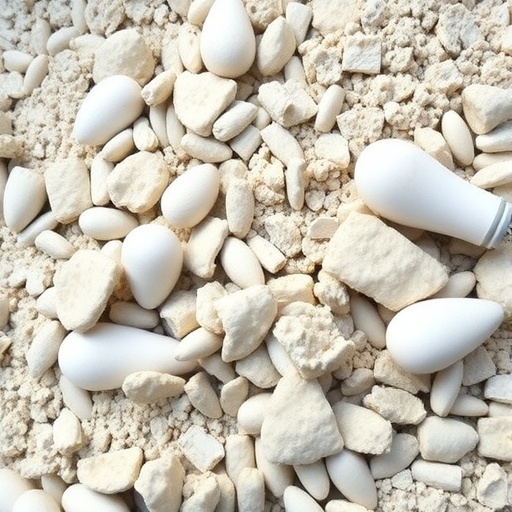In recent years, the construction industry has faced significant scrutiny regarding its environmental footprint, particularly concerning cement production. Traditional cement manufacturing is notoriously carbon-intensive, accounting for approximately 8% of global carbon dioxide emissions. This staggering statistic underscores the urgent need for sustainable alternatives in construction materials. Researchers have begun to explore various approaches to mitigate these environmental impacts, among which the utilization of waste materials has surfaced as a promising solution. A groundbreaking review article by Rakesh and Kumar delves into the potential of limestone and eggshell waste as effective replacements for cement, presenting compelling insights into their benefits and challenges.
The review meticulously examines the chemical composition and properties of both limestone and eggshells, offering a detailed analysis of how these materials can serve as partial substitutes for traditional cement. Limestone, primarily composed of calcium carbonate, possesses favorable chemical characteristics that make it an excellent candidate for cement replacement. When calcined, limestone transforms into quicklime, which can subsequently combine with water to form calcium hydroxide, thereby enhancing the material’s binding properties. This process not only reduces reliance on conventional cement but also yields a product that maintains structural integrity.
Eggshell waste, on the other hand, has historically been neglected and often discarded as a food industry byproduct. However, the researchers highlight that eggshells are largely comprised of calcium carbonate, akin to limestone. This shared elemental foundation is key to understanding why eggshells can serve as effective replacements in cement mixtures. The incorporation of eggshell waste not only enhances the mechanical properties of concrete but also contributes to waste reduction, showcasing a dual benefit of ecological and functional significance.
An important aspect covered in the review is the environmental implications of using limestone and eggshells as cement substitutes. By utilizing these waste materials, industries can significantly decrease their carbon footprint, aligning with global initiatives aimed at reducing greenhouse gas emissions. The authors present data indicating that replacing a portion of traditional cement with limestone and eggshells can lead to substantial reductions in CO2 emissions associated with the cement hydration process. This shift towards more sustainable materials is vital for aligning construction practices with environmental stewardship.
Further, the review outlines experimental studies where varying proportions of limestone and eggshells have been tested in cement formulations. The results demonstrate that optimized combinations of these materials can achieve satisfactory compressive strength while maintaining workability. This is particularly crucial for construction applications where high performance and durability are required. Additionally, the findings suggest that the use of alternative materials can improve the resistance of concrete to environmental degradation, thus extending the lifespan of structures.
Moreover, the economic viability of incorporating limestone and eggshell waste into cement production is another focal point of the review. The researchers argue that the abundant availability of these materials can lower raw material costs in construction. Eggs, being a staple food source, generate significant amounts of waste across various industries. By redirecting this waste into construction applications, companies can not only enhance profitability but also foster a circular economy model that emphasizes resource efficiency and sustainability.
The authors also address potential challenges that may arise from the widespread adoption of limestone and eggshell waste in cement production. Variability in the chemical composition of eggshells, influenced by factors such as the source and processing methods, can lead to inconsistencies in performance. This heterogeneity necessitates rigorous quality control measures to ensure uniformity in the final product. Furthermore, the review calls for further research to establish standardized protocols for the processing and testing of these alternative materials.
Importantly, the review does not shy away from addressing the implications of regulatory frameworks on the acceptance and implementation of these alternative materials. As construction practices evolve, there is a pressing need for updated building codes and standards that accommodate innovative materials like limestone and eggshells. The authors emphasize the role of policymakers in facilitating this transition, advocating for supportive legislation that incentivizes the use of sustainable construction methods.
Additionally, collaborations between academia, industry, and government entities are highlighted as crucial for advancing the use of these alternative materials. By fostering partnerships that prioritize research and development, stakeholders can work towards scaling up production and integrating these solutions into mainstream building practices. This collaborative approach can lead to breakthroughs that address both environmental concerns and infrastructural demands.
As the review concludes, Rakesh and Kumar reiterate the importance of continued exploration into the potential of limestone and eggshell waste. They advocate for more comprehensive studies that delve into long-term performance, durability, and environmental impacts of blended cements. As the global construction industry seeks pathways to reduce its carbon emissions, the insights gained from this review are timely and significant, underscoring the pivotal role of waste materials in shaping a sustainable future.
In summary, Rakesh and Kumar’s review elucidates the transformative potential of limestone and eggshell waste as cement replacements. Through careful analysis of their chemical properties, environmental benefits, and economic implications, the authors provide a roadmap for integrating these materials into construction practices. This innovative approach not only addresses the pressing challenges of carbon emissions and waste management, but also paves the way for a more sustainable and resilient built environment. As the urgency for sustainable solutions continues to mount, the exploration of alternative materials like limestone and eggshells stands as a beacon of hope for the future of construction.
Subject of Research: Evaluating the effectiveness of limestone and eggshell waste as cement replacements
Article Title: Evaluating the effectiveness of limestone and eggshell waste as cement replacements — a review
Article References:
Rakesh, M.V.R., Kumar, N. Evaluating the effectiveness of limestone and eggshell waste as cement replacements — a review. Environ Sci Pollut Res (2025). https://doi.org/10.1007/s11356-025-36993-1
Image Credits: AI Generated
DOI: 10.1007/s11356-025-36993-1
Keywords: limestone, eggshell waste, cement replacement, sustainable construction, environmental impact, concrete durability, circular economy.




